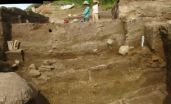(Press-News.org) Charred grains of barley, millet and wheat deposited nearly 5,000 years ago at campsites in the high plains of Kazakhstan show that nomadic sheepherders played a surprisingly important role in the early spread of domesticated crops throughout a mountainous east-west corridor along the historic Silk Road, suggests new research from Washington University in St. Louis.
"Our findings indicate that ancient nomadic pastoralists were key players in an east-west network that linked innovations and commodities between present-day China and southwest Asia," said study co-author Michael Frachetti, PhD, an associate professor of archaeology in Arts & Sciences at Washington University and principal investigator on the research project.
"Ancient wheat and broomcorn millet, recovered in nomadic campsites in Kazakhstan, show that prehistoric herders in Central Eurasia had incorporated both regional crops into their economy and rituals nearly 5,000 years ago, pushing back the chronology of interaction along the territory of the 'Silk Road' more than 2,000 years," Frachetti said.
The study, to be published April 2 in the Proceedings of the Royal Society B, establishes that several strains of ancient grains and peas had made their way across Eurasia thousands of years earlier than previously documented.
While these crops have been known to exist much earlier in ancient China and Southwest Asia, finding them intermingled in the Bronze Age burials and households of nomadic pastoralists provides some of the earliest concrete signs for east-west interaction in the vast expanse of Eurasian mountains and the first botanical evidence for farming among Bronze Age nomads.
Bread wheat, cultivated at least 6,000 years ago in Southwest Asia, was absent in China before 2500 B.C. while broomcorn millet, domesticated 8,000 years ago in China, is missing in southwest Asia before 2000 B.C. This study documents that ancient grains from eastern China and soutwest Asia had made their way to Kazakhstan in the center of the continent by 2700-2500 B.C. (nearly 5,000 years ago).
"This study starts to rewrite the model for economic change across Eurasia," said first author Robert Spengler, PhD, a paleoethnobotanist and research associate in Arts & Sciences at WUSTL.
"It illustrates that nomads had diverse economic systems and were important for reshaping economic spheres more generally."
Findings are based on archaeobotanical data collected from four Bronze Age pastoralist campsites in Central Eurasian steppe/mountains: Tasbas and Begash in the highlands of Kazakhstan and Ojakly and Site 1211/1219 in Turkmenistan.
"This is one of the first systematic applications of archaeobotany in the region, making the potential for further future discovery very exciting," Spengler said.
Frachetti and a team of WUSTL researchers led the on-site excavations, working closely with archaeologists based in Turkmenistan, Kazakhstan and Italy. Spengler conducted the paleoethnobotany laboratory work at WUSTL, under the directorship of Gayle J. Fritz, PhD, professor of archaeology and expert in human-plant relationships.
"Finding this diverse crop assemblage at Tasbas and Begash illustrates first evidence for the westward spread of East Asian and Southwest Asian crops eastward, and the surprise is that it is nomads who are the agents of change," Frachetti said.
INFORMATION:Washington University co-authors include three anthropology graduate students: Paula Doumani, Lynne Rouse and Elissa Bullion. Doumani led the excavations at Tasbas in Kazakhstan while Rouse co-led the excavations at Ojakly in Turkmenistan.
Other co-authors are Barbara Cerasetti, of the Universita`degli Studi di Bologna, Italy, and Alexei Mar'yashev, of the Institute of Archaeology in Kazakhstan.
Funding was provided by National Science Foundation grant nos. 1010678, 0535341, 1132090 and 1036942, as well as Lambda Alpha National Honor Society, the Mary Morris-Stein Foundation, Wenner-Gren grant no. 8157, George F. Dales Foundation and International Research & Exchanges Board IARO.
Ancient nomads spread earliest domestic grains along Silk Road, study finds
Findings push back earliest known East-West interaction along Slik Road by 2,000 years
2014-04-02
ELSE PRESS RELEASES FROM THIS DATE:
Unvaccinated infants act as 'kindling' to fuel epidemics
2014-04-02
ANN ARBOR—Nearly 4 million children under 5 die from vaccine-preventable diseases worldwide each year, and two University of Michigan doctoral ecology students are working to change that.
By taking into account seasonal fluctuations in birth rates, massive vaccination campaigns in the developing world could inoculate more unprotected infants and significantly reduce the number of deaths from diseases like measles, according to Micaela Martinez-Bakker and Kevin Bakker of the U-M Department of Ecology and Evolutionary Biology.
"If you have lots of kindling, you can have ...
Care of heart failure patients falling short in the UK
2014-04-02
Care of patients with heart failure in the UK is inadequate and has not changed in a decade, according to new research published in BMJ Open.
The findings by a team at Durham University and Darlington Memorial Hospital - and funded by national charity Heart Research UK - highlight inadequacies in heart failure care as well as an uncoordinated approach to diagnosis and management of the condition between primary and secondary care clinicians.
The research showed that clinicians are uncertain about how to diagnose different types of heart failure and about who has overall ...
Warm North Atlantic Ocean promotes extreme winters in US and Europe
2014-04-02
The extreme cold weather observed across Europe and the east coast of the US in recent winters could be partly down to natural, long-term variations in sea surface temperatures, according to a new study published today.
Researchers from the University of California Irvine have shown that a phenomenon known as the Atlantic Multidecadal Oscillation (AMO)—a natural pattern of variation in North Atlantic sea surface temperatures that switches between a positive and negative phase every 60-70 years—can affect an atmospheric circulation pattern, known as the North Atlantic ...
Not so dirty: Methane fuels life in pristine chalk rivers
2014-04-02
Scientists from Queen Mary University of London have found that naturally high concentrations of the greenhouse gas methane contributes to energy production in chalk rivers, in a new study published today in the journal Proceedings of the Royal Society B.
Chalk rivers, found from Dorset to Cambridgeshire, sustain a diverse range of protected animals and plants, and are renowned globally for fly fishing, an industry worth more than £4M on the Rivers Test and Itchen (Hampshire) alone.
"It's a surprise to find methane is such a big source of energy in these gin-clear ...
Male extinction prevented by promiscuous females
2014-04-02
LIVERPOOL, UK – 2 April 2014: Female fruit flies with a large number of sexual partners are playing an invaluable role in preventing the extinction of males, research at the University of Liverpool has shown.
Scientists have found that flies in the northern parts of the United States are more inclined to have multiple partners in order to reduce the occurrence of an X chromosome which causes the production of only female offspring.
This selfish genetic element (SGE) tries to replicate itself by killing sperm that carry the Y chromosome, but has the side-effect that ...
Still no clear evidence for health benefits of vitamin D
2014-04-02
They argue that "universal conclusions about its benefits cannot be drawn" and say further studies and better designed trials are needed.
A growing body of evidence indicates that vitamin D may reduce risks of a wide range of diseases, including bone mineral disease, multiple sclerosis, autoimmune disorders, cancer and cardiovascular problems. Yet, despite hundreds of trials, the evidence for vitamin D is still being debated.
Two papers published on bmj.com today attempt to make sense of the existing data.
The first, by researchers based in the UK, Europe and USA, ...
Probiotics do not help infants with colic
2014-04-02
These findings differ from previous smaller trials and do not support a general recommendation for the use of probiotics to treat colic in infants.
Infant colic (excessive crying of unknown cause) affects up to 20% of infants and is a major burden to families and health services. Although it spontaneously resolves three to four months after birth, its cause remains elusive and no single effective treatment exists.
Previous small trials suggest that the probiotic Lactobacillus reuteri effectively treats colic in breastfed infants. These studies, however, had limitations ...
New dementia diagnosis targets will lead to overdiagnosis
2014-04-02
The government is putting pressure on commissioners, and in turn general practitioners, to make more diagnoses of dementia, but no analysis has been done to assess the harm that these targets could cause.
Dr Martin Brunet, a GP from Surrey, says that "medicine depends on a fundamental, unspoken agreement between patients and doctors […] the only factor influencing the decision to diagnose should be the best interests of patients". He adds that the idea of doctors being motivated by self interest is "abhorrent and undermines the basis of the relationship".
He says that ...
The Sun's campaign may actually harm women
2014-04-02
The "check 'em Tuesday" campaign is a weekly call for women to examine their breasts. Readers are asked to send in photos to prove compliance and can even sign up for a text message reminder.
But Dr McCartney argues that teaching women to examine their breasts regularly "has been shown not to reduce deaths from breast cancer and actually increases the chances of a benign biopsy result." She says it is "unfair to tell women that regular self examination will save their lives when it may simply incur anxiety and have the potential to harm."
She points out that this is ...
Screening for liver cancer in patients with cirrhosis
2014-04-02
In a systematic review and meta-analysis of 47 studies with 15,158 patients, Amit Singal (University of Texas Southwestern Medical Center) and colleagues found that patients with cirrhosis who underwent surveillance (via liver ultrasound with or without measurement of serum alpha fetoprotein) for hepatocellular carcinoma (HCC) had cancers detected at an earlier stage, were more likely to receive curative instead of palliative treatment, and had longer survival. Across all the studies, the pooled 3-year survival rate was 50.8% among the 4735 patients who underwent HCC surveillance, ...
LAST 30 PRESS RELEASES:
New evidence challenges understanding of Parkinson’s disease
A new study reveals how embryos and the uterus “talk” during implantation
Cedars-Sinai reports heart attacks, general illness spiked after LA fires
PolyU develops ultra-stable, mucus-inspired hydrogel to boost gastrointestinal wound healing
Flour choice shapes sourdough microbial communities
Can a retinal implant reverse macular degeneration?
Feeding fungi plant remnants produces tasty protein to fortify vegan, vegetarian diets
New tech reduces false positives from breast ultrasounds
Drone-mounted lab monitors fertilizer runoff in real time
Short, light-intensity exercise boosts executive function and elevates mood in children
Jeonbuk National University researchers reveal new interface engineering strategy for efficient and stable back-contact solar cells
Tyrosinase drives hydroquinone-induced exogenous ochronosis: not HGD inhibition
UMass Amherst chemists develop unique tool for studying RNA
Disappointment alters brain chemistry and behavior
A built-in odometer: new study reveals how the brain measures distance
Stress-related brain signals drive risk of cardiovascular disease in people with depression and anxiety
New details on role of fat transport molecules in Alzheimer’s onset
Study illuminates how an antiviral defense mechanism may lead to Alzheimer’s disease
Spot the males: New gene-editing method could transform mosquito control
AI learns to build simple equations for complex systems
NAU team releases 13 years of detailed U.S. CO2 emissions data
Unveiling how sodium-ion batteries can charge faster than lithium-ion ones
How do childcare tax credits affect children’s long-term health?
Can an electronic nose detect indoor mold?
Do natural disasters have long-term impacts on mortality in older adults?
Modification improves sodium‐ion batteries as an alternative to lithium-ion batteries
Parasports provide a range of benefits for people with cerebral palsy
How does grandparental care affect children’s health?
Why are there so many Nordic mediators?
Young shark species more vulnerable to extinction
[Press-News.org] Ancient nomads spread earliest domestic grains along Silk Road, study findsFindings push back earliest known East-West interaction along Slik Road by 2,000 years



